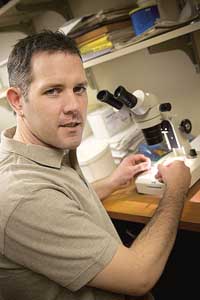Psychologist studies how the changes in daylight affect mood
By William HarmsNews Office
 Brian Prendergast | |
Among the mechanisms that regulate reproduction and health in humans and other animals is a biological clock, which researchers had thought was regulated primarily by sunlight until work by Brian Prendergast, Assistant Professor in Psychology, showed memory and genetics also play a role.
For his work, Prendergast recently received the Frank A. Beach Award as the year’s outstanding young investigator in the field of behavioral neuroendocrinology from the Society for Neurosciences Meetings in San Diego.
“When an animal exhibits a given behavior or initiates a physiological process can be as important as whether it does so at all,” Prendergast said. “From daily patterns of arousal and attention to annual patterns of reproduction and illness, biological clocks impinge on the behavior and physiology of humans and other animals.”
Prendergast and researchers in his lab at the Institute for Mind and Biology are doing experiments to better understand the internal representation of time by identifying neural and hormonal mechanisms by which humans and other animals mark the seasons.
In humans, for instance, one relationship between seasons and health relates to the occurrence of disease. For reasons researchers do not totally understand, measles are much more common between March and June while cases of whooping cough peak in July.
Although some people report feeling more depressed during short winter days, seasonal disorder in humans is rare, affecting probably 1 to 3 percent of the population. The invention of electric lights has reduced the impact of seasonal changes affected by light on people’s moods, Prendergast said.
For small animals, the impact of light on biological clocks can be significant.
“For most lab studies of rats, for example, the animals are kept in the dark for 12 hours and in the light for 12 hours,” Prendergast said. “They become depressed and anxious.”
“We did an experiment in which we increased the light the rats were exposed to, and the results were dramatic. The rats became much less depressed and anxious after being exposed to just two additional hours of light,” he explained.
Prendergast explored the connection between daylight and mood among animals in a recent paper published this month, titled “Affective Responses to Day Length in Siberian Hamsters.” The paper explores the impact of changes in daylight (photoperiod) on a more complex level than has previously been studied.
To determine the impact of daylight on animals’ anxiety, Prendergast and his colleagues tested male and female hamsters exposed to varying amounts of light. They then measured their anxiety and depression levels by several indicators, including how quickly they entered an open area in a maze and how quickly they sought food.
In all cases, the male hamsters exposed to less light responded with less energy than did the hamsters exposed to longer light. They were slower to enter open areas on a maze and slower to search for food. Female hamsters exposed to shorter daylight were less anxious than males, Prendergast said, though it is unclear why.
Prendergast also studies rodents to see how seasonal changes regulate reproductive cycles. To survive, the animals need to be able to reproduce during the warm months and conserve energy during the winter months when food is less available. Scientists had thought that the simple change in daylight prompted changes, which caused sexual organs to grow.
“But if it were just a matter of daylight, how would the hamster be able to distinguish between spring and fall, when the length of the day is about the same?” Prendergast wondered. Without the ability to make the distinction, the animals’ sex organs could grow with the onset of autumn.
In the process of figuring out how the animals distinguish the changes, Prendergast discovered that hamsters have a memory. They use a recollection of longer days during the summer to slow down their systems as winter approaches. But that memory is erased by the time spring comes, so their ability to grow large sex organs returns.
Prendergast discovered hamsters have memory when he exposed them to varying periods of long, summer-like light and different durations of 15-hour days. Some were exposed for a week, others for two weeks and so on, up to three months of long days. They then were tested to see if their testicle size became smaller when the length of the day was shortened to seven hours.
“Animals that saw one week of longer days had no response to intermediate-length days,” he said. “After two weeks of long days or more, they interpreted an intermediate-length day as ‘short.’ That shows they acquired the long-day memory,” he said. Further tests showed the hamsters lost the memory of the summer days after nearly 13 weeks and accordingly, when the experimental day lengths returned to intermediate length, their testicles failed to get smaller.
![[Chronicle]](/images/sidebar_header_oct06.gif)